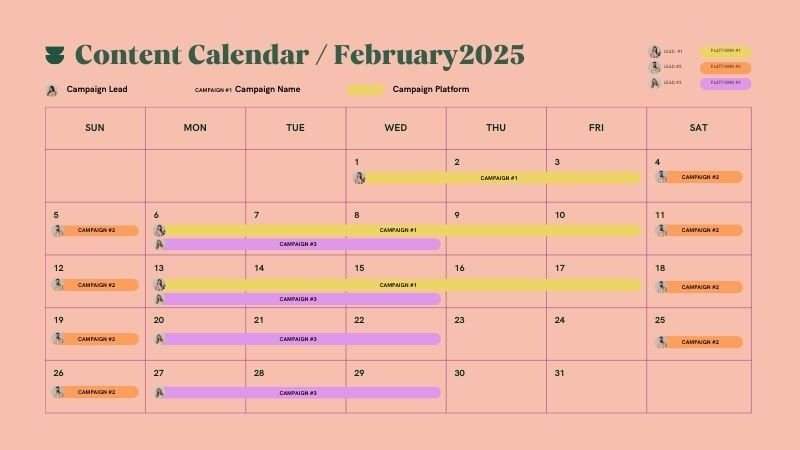Imagine that you are organizing an event to promote your business without any arrangements, invitations, rehearsals, and financial oversight taken care of beforehand. Would it be a success for your business? Let me help you a bit more with the outcome. Presenters are coming in a disorderly manner, creating no logical link between ideas; the right audience is not there to appreciate your effort, and the venue is inappropriate to get you the right masses as per your niche. Don’t you think the whole ceremony would be chaotic and leave you with an everlasting regret and business loss? That’s why content planning is crucial to get your business floated, secure your funding, start operations, gain market presence among relevant traffic, and harvest long-term results.
In the pursuit of effective brand building, social media has become an epicenter of communication and marketing. So, to roll out and flourish your business, learning the art of social media content planning to its core is no longer just an option; it’s a necessity. Effective social media content planning ensures that your social media presence is coherent, engaging, and strategically aligned with your ultimate goals. This blog will help you comprehend the intricacies of social media content planning by shedding light on its key ingredients, such as why it’s crucial, how to craft a successful strategy, and tips for ongoing optimization.
How to Make a Social Media Content Plan
Creating a comprehensive social media content plan involves several key steps:
1. Define Your Goals
Before setting the sails, you must devise a clear and measurable goal. Whether you are aiming to increase your brand’s awareness, drive traffic to your website, or boost your engagement rate, you must have a clear vision of what you desire to gain out of it. Defining your objectives early will guide your content strategy and help you focus your efforts.
Also Read 17 Best Social Media Content Creation Tools for 2025 You Need to Know
2. Know Your Audience
The second step demands a complete understanding of your targeted audience’s interests, behaviors, requirements, and locations before stepping into the real field. Conduct research to determine their preferences, behaviors, and demographics. You can utilize analytics tools to gather data on their engagement patterns and interests. This insight will help you create content that resonates with your audience’s preferences.
3. Choose Your Platforms
Not all social media platforms possess similar features. Neither do they have all similar audiences nor similar interfaces, content-creating tools, and styles. Each has its own unique audience and content style. To choose the best platform for your brand’s promotion, decide which platforms align with your brand and where your relevant audience is most active. Focus on quality over quantity and maintain a strong presence on a few platforms that are more suitable for your brand and convenient to manage rather than spreading yourself too thin.
4. Develop a Content Calendar
A content calendar serves as a roadmap for consistent posting. Plan out your content’s essence, such as themes, topics, and a complete posting schedule to avoid missing the regular task. The content calendar must include content types, frequency of posting on each platform, and key dates such as holidays, events, or product launches to plan relevant content. Decide beforehand on the variety of content you will produce: images, blog posts, infographics, and videos.
5. Create Compelling Content
As Mari Smith says, “Content is King, but engagement is Queen, and the lady rules the house,” this quote emphasizes the importance of content in any business’s success. The content you create must be engaging and relevant. Craft content that speaks to your audience’s needs and interests. Use a mix of formats such as articles, videos, polls, and images to keep your feed dynamic. Ensure your content is visually appealing and aligned with your brand’s voice.
Also Read Social Media Marketing on Facebook: Boost Your Business Today
6. Implement a Review Process
Before publishing your content online, review it carefully to ensure it’s ready to go. Proofread for any errors, and verify that it aligns with your brand’s guidelines. A thorough review helps maintain quality and professionalism.
7. Monitor and Adjust
Once your content is live, monitor its performance. Use analytics tools to track metrics such as engagement, reach, and conversion rates. Based on these insights, adjust your strategy as needed. Regular monitoring ensures you refine your approach for better outcomes over time.
Key Statistics and Examples
- According to Sprout Social, 73% of marketers believe their social media efforts have been “somewhat effective” or “very effective” for their business.
- Example: A small bakery increased its sales by 30% in six months by consistently sharing visually appealing content on Instagram, combined with user-generated posts from happy customers.
Advanced Tips
- Leverage AI Tools: Utilize AI tools like ChatGPT for caption ideas, analytics tools for performance insights, and design platforms like Canva for creating professional visuals.
- Focus on Trends: Incorporate user-generated content and collaborate with influencers to enhance credibility.
- Use Hashtags Strategically: Research trending and niche-specific hashtags to boost visibility.
Call-to-Action (CTA) for Engagement
- Download our free social media content calendar template to streamline your planning process.
- Subscribe to our newsletter for weekly social media tips and strategies.
- Share this blog with your team to start creating impactful social media content today.
Why Choose Ghani’s Creative Hub for Your Social Media Needs?
At Ghani’s Creative Hub, we understand the dynamics of social media better than anyone else. With 7+ years of experience and a team of experts, we provide tailored solutions to help your brand stand out. Whether you need assistance with content creation, platform management, or advanced analytics, our team is here to ensure your social media strategy yields exceptional results.
Let us help you turn your social media into a powerful tool for business growth. Contact us today to get started on your journey to success.
Conclusion
Social media content planning is a blend of art and science. It requires creativity to craft engaging content and strategic thinking to align that content with your goals. By understanding your audience, setting clear objectives, and continuously refining your approach, you can build a strong social media presence that drives results. Remember, the key to success lies in planning ahead, staying adaptable, and being genuinely engaged with your audience.
FAQs
Q1. What is social media content planning?
Ans: Social media content planning pertains to the strategic creation and posting of content while managing it effectively across social media accounts.
Q2. How can I plan my social media content?
Ans: Understand your audience by analyzing their demographics, behaviors, and preferences. Create relevant content, schedule posts consistently, and monitor metrics regularly to stay aligned with your goals.
Q3. What tools can help with content planning?
Ans: Tools like Hootsuite, Buffer, and Trello are great for planning, scheduling, and tracking content. Design tools like Canva can enhance visual content creation.

